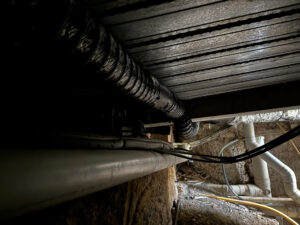Maintaining a smooth-running home ventilation system is essential not only for the comfort but also for the health of everyone dwelling within. As we continue to spend considerable amounts of time indoors, the significance of clean and well-functioning ventilation cannot be overstressed. From controlling moisture levels to eliminating pollutants, a robust ventilation system supports a healthier living environment, reducing the risks of allergens and mould growth.
In our commitment to ensuring every home enjoys the best indoor air quality, we’ve gathered some fundamental insights into keeping your ventilation system running without a hitch. Tackling these can often seem daunting, but simplifying these tasks into manageable actions can make a significant difference. Whether you’re a new homeowner or have been in your residence for years, understanding how your system works and regular upkeep can prolong its lifespan and enhance its efficiency.
Ensuring your home’s air is clean and fresh is easier than you might think. Stick with us as we dive into practical tips and expert advice on maintaining your ventilation effectively. With the right knowledge, we can tackle this together, keeping our homes airy and our families healthy.
Understanding Your Home’s Ventilation System
First things first, it’s pivotal that we grasp how our home’s ventilation system works. Essentially, these systems are engineered to replace stale indoor air with fresh outdoor air, helping to manage humidity, expel odours, and eliminate pollutants. Most systems consist of various components such as fans, ducts, filters, and vents. Understanding each component’s role helps you maintain them better and recognise when they aren’t working correctly. For instance, exhaust fans pull the moist air out of your bathrooms and kitchen, while intake vents draw in the external air necessary to keep your home’s air fresh.
Moreover, different types of ventilation—such as natural, exhaust, and balanced—serve distinct purposes and are suited to particular climates and home designs. By understanding the type your home uses, we can better tailor maintenance efforts to suit specific needs, ensuring each part functions optimally for longer.
Regular Cleaning Routines for Maximum Efficiency
Maintaining peak efficiency of your ventilation system doesn’t just happen; it requires a regular cleaning routine. Let’s start with the basics: ensuring that all filters are cleaned or replaced every three months, or more often if you have pets or live in a high-pollen area. Dirty filters not only degrade air quality but also make your system work harder, increasing energy costs.
Next up, ducts and vents need attention, too. Dust and debris can accumulate in these areas and restrict airflow, which strains the system and potentially leads to damage. Taking a vacuum to the accessible parts of your ducts can help, and occasionally, hiring professionals to clean those hard-to-reach places makes a significant difference. Also, keeping the external components of your system, like vents and fan blades, free from obstruction ensures they operate efficiently. This routine maintenance not only extends the lifespan of the system but also upholds a high standard of indoor air quality in your home.
Common Issues and How to Fix Them
We understand that even with the best care, your home’s ventilation can run into some common issues, and knowing how to tackle these can save you both time and discomfort. One frequent problem is the presence of unusual noises, which might suggest an obstruction or a failing motor. If it’s a noise issue, checking for loose parts and ensuring that nothing is obstructing the fan or vents can often provide a quick fix. Squeaky sounds usually mean it’s time to lubricate the fan bearings.
Another common challenge is inadequate airflow. This can often be caused by blocked or dirty filters, crushed or blocked ducts, or incorrect settings on your thermostat. Reviewing and clearing up these elements often restore optimal function without needing professional help. However, if the problem persists, this might be an indication of a more significant issue, such as a breach in the ductwork or a severely damaged component.
When to Call in the Professionals for Ventilation Maintenance
Sometimes, despite our best efforts, a professional touch is required to ensure our home ventilation systems are running as they should. It’s important to recognise when a situation is beyond a simple DIY fix. If you’ve noticed persistent issues like drastic changes in heating or cooling expenses despite normal usage, it may indicate an inefficiency in your system that needs professional diagnosis. Similarly, any persistent odours or unusual sounds after you’ve performed routine checks and maintenance should be looked at by a specialist.
Regarding ventilation, a small issue can quickly escalate into a costly repair if not addressed promptly. We recommend scheduling at least an annual check-up with a trusted professional who can conduct a comprehensive assessment and maintenance. This not only ensures your system operates efficiently but also extends its lifespan, ultimately saving you money and keeping your air clean and fresh.
To maintain a healthy home and ensure your ventilation system serves you well through the seasons, staying informed and proactive about maintenance is key. Keep an eye on the performance of your system, and don’t hesitate to reach out for expert help when necessary. At Western Sydney Ventilation, we pride ourselves on providing top-notch service and expert advice for any issue you might face with your home’s ventilation. Whether you need routine maintenance, emergency repairs, or just some advice on improving your air quality with reliable home ventilation systems, give us a call today—we’re here to help you breathe easier!

